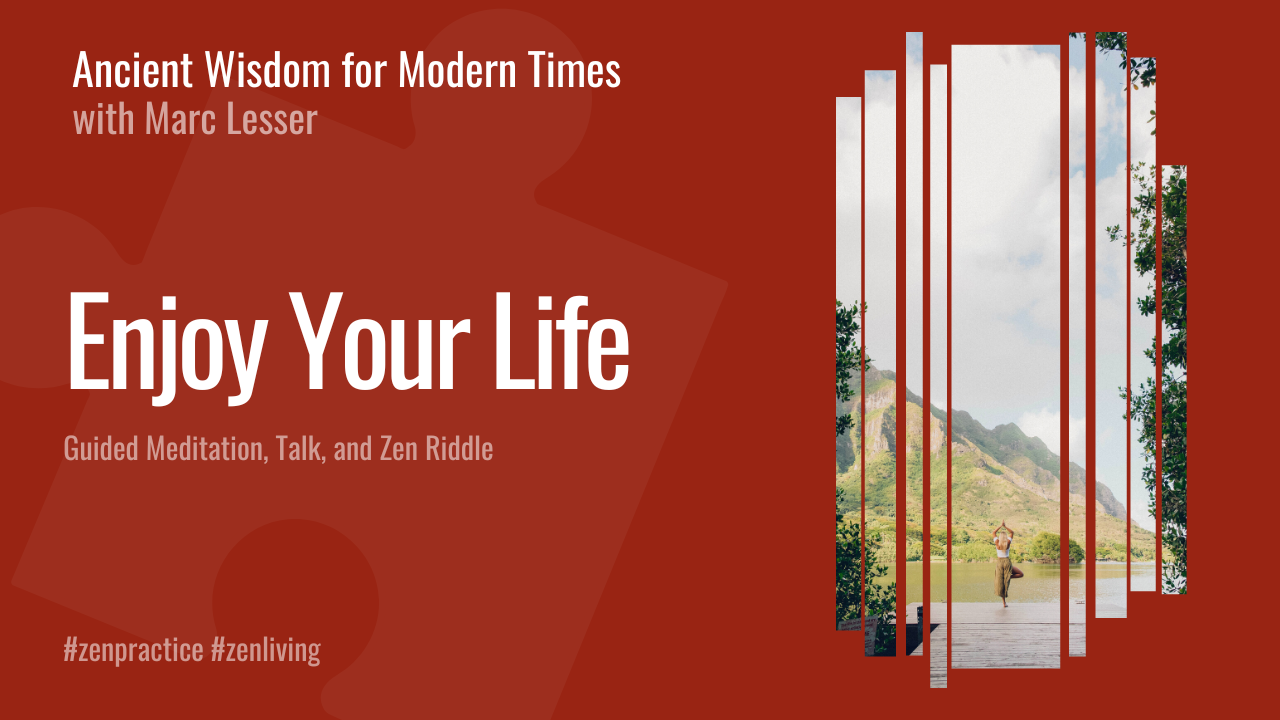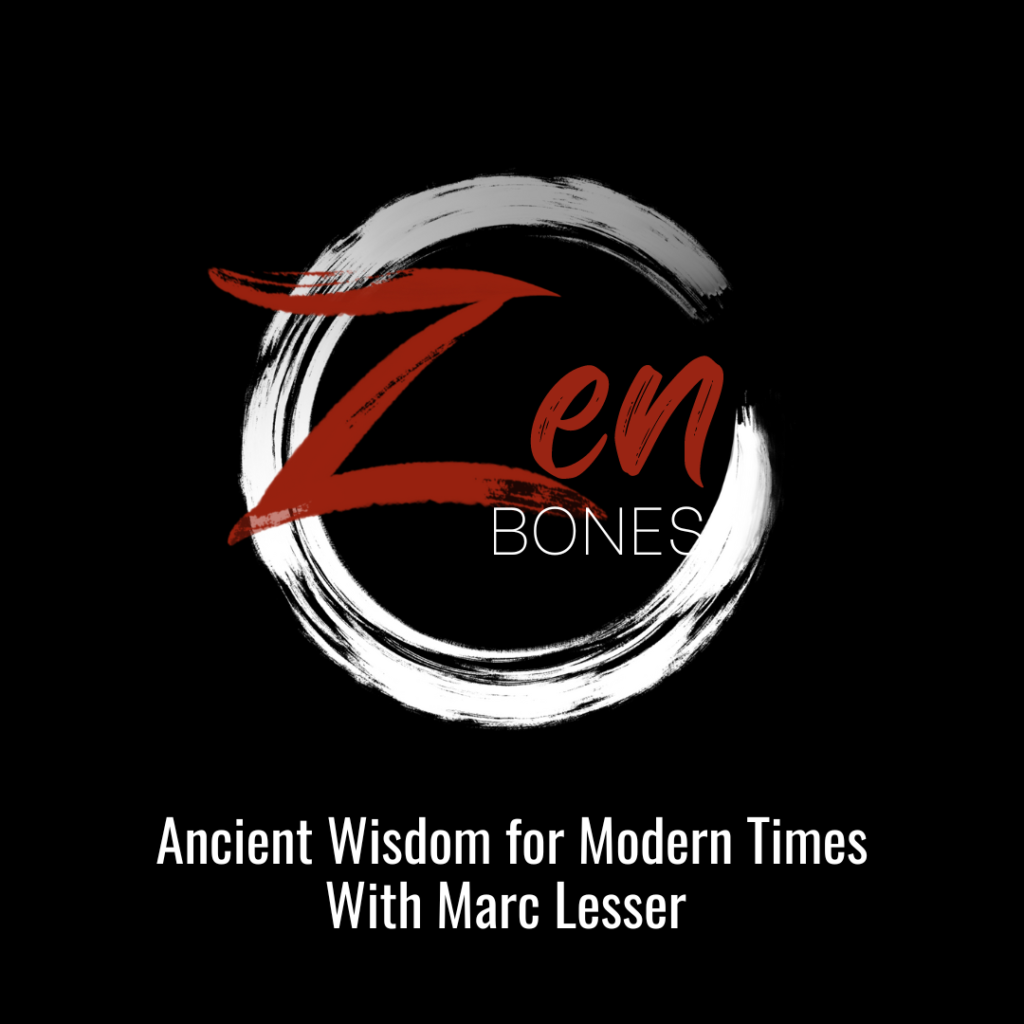Marc begins with a guided meditation, followed by a short talk on impermanence as a path toward joy. “The evanescence of things is the reason why you enjoy your life” according to the Zen teacher Shunryu Suzuki. Recognizing and embodying the fleeting nature of our lives is a way to practice with finding more appreciation and joy in everything we experience. The episode closes with a bi-weekly Zen Puzzler: Where is the place where there is no hot and no cold?
EPISODE TRANSCRIPT
[00:00:00] Marc Lesser: Welcome to ZenBones: Ancient Wisdom for Modern Times. This is Marc Lesser. Why ZenBones? Our world is in crisis and ever-shifting. Now more than ever, more wisdom, clarity, and courage are essential, especially in the world of work, business, and leadership.
Welcome to a practice episode called Enjoy Your Life, in which instead of an interview, it will be a series of practices, a guided meditation followed by a short talk in which the themes will be Enjoy Your Life.
In the talk, the emphasis is on embracing impermanence and how through entering the evanescence of life is the way to find a more sustainable enjoyment. Then I’ll be offering a Zen puzzler, which I’m really excited about — a Zen question or “Koan” or a puzzle that we can bring into our daily lives. This week, the puzzler is: Where is the place where there is no hot and no cold? I hope you enjoy this episode.
[music]
Let’s start with a short meditation. I’m going to begin by getting us started by ringing my trustee bell. This bell has been around the world many, many times. I have no idea where it came from. I think it was back when I was living at the Tassajara Mountain Center, which is now more than 40 years ago.
[bell ringing]
This practice of pausing, this practice of stopping, see if it’s possible. Can you pause right now? Can you stop right now and notice? Notice your body. A simple way to do that is to bring attention to your shoulders, relaxing the shoulders, relaxing the muscles, the upper back, opening the shoulders and chest, and allowing breathing. Noticing any place where you might be constricting and seeing if you can give that place just a little more attention. Relaxing the shoulders, relaxing the upper back, letting the muscles in the face soften, relaxing the jaw. Maybe just taking in the experience, your experience of the whole body, softening the belly, and some energy in the spine. I think of this practice in a way as cultivating being both completely relaxed and completely alert at the same time.
What a great way of being for almost everything in our lives and so cultivating, this way of being relaxed, nothing to accomplish, and nothing to change. What a relief, just feeling that sense of letting down our burden. We don’t need to accomplish anything, change anything, and at the same time, this feeling of aliveness, and awakeness energy.
Then I would invite you to gently bring attention to the breath. And just noticing the miracle that we so easily ignore or take for granted. Can you bring a childlike quality to bringing awareness to this breath right now? This breath that has never happened before and will never happen again. It’s fleeting. The nowness, entering this very moment, being curious about the breath. Again, we’re not going to stop our thinking minds, let thoughts come and let them go. Particularly letting go of the thoughts about our to-do lists, our comparisons, and judgments. Notice them. Enjoy them, whatever comes up. See if you can be curious and enjoy getting to be more familiar with the body, with the breath, with thinking mind. Can you enjoy and appreciate all of it? Whatever it is, whether there’s sadness or longing or calm and settled or whatever’s there. Even all of the unnamable feelings and thoughts, let them come, let them go, appreciate them and enjoy them as much as possible. Noticing the breath in the body and your experience of being here alive, relaxed and alert, curious and filled with appreciation, and keeping it simple. Breathing in and breathing out.
Let’s sit quietly together for 30 seconds of silence right now.
[pause 00:08:35]
Amazing. In just half of a minute, the whole world is right there in our breath, in our experience. My hope is that you can take this way of being, this state of mind into your day, into everything that you do. Relaxed, alert, enjoying each moment even the difficulties and challenges, especially. You can always come back, even during your work, daily activities, you can always come back to the body and the breath. [silence] Breathing in, and breathing out, [bell ringing] and gently coming back and bringing attention to being here. Thank you.
[music]
I just want to talk this morning about the practice of enjoyment, the practice of enjoying our lives. I was thinking about that I recently returned from a trip to Montana where I was visiting my daughter and her family. There was something really poignant about being with my three-year-old grandson. When I’m with him, I can’t help but wonder how much of his life will I be alive for. How much of his life will I be alive for? In some way, this question is barely conscious and at the same time, very much in the forefront of my thoughts when I’m with him.
There’s something about feeling the evanescence of things, the impermanence of things which can bring up a sense of deep appreciation and actually a sense of joy. I’ve more been taking on this practice of seeing things as what if this were the last time that I was with my grandson.
We can do this practice of — I think of it as the last time practice. Because we never know, when it might be the last time that we’re doing anything that we’re with our partners, or our children, or our parents, or whatever it is, but just thinking of it that way.
I think of Shunryu Suzuki who is the founder of the San Francisco Zen Center. Though I never met him, I came to Zen Center just a few years after he died. I still think of him as one of my core teachers. One of the things that he says in a talk entitled Enjoy Your Life, he says, “The evanescence of things is the reason why you enjoy your life.” I actually needed to look up the word evanescence and saw that it means the quality of things disappearing.
Right now, reality is that everything is disappearing. In fact, everything is in the process of appearing and disappearing, including the garbage trucks right outside my door right now which I think we should keep those in, not edit those out because they’re beautiful. My grandson gets so excited when the garbage trucks come on Friday morning, we go and find them, and he’s like he has just discovered the most incredible jewels that exist standing by the window and just in awe watching the garbage trucks.
When I’m with him, one of his favorite things to do is together, we watch garbage truck videos. If you haven’t done it, I highly recommend. They’re called Thrash and Trash. [chuckles] Anyhow, this quality of appreciating everything. Somehow, we human beings have been given the gift of awareness of time. Somehow, we seem to pay attention to time in a way that can either trap us or free us. We’re capable of seeing, feeling, and living our lives with this quality of evanescence, this quality of appreciating this moment or we can be caught. We can let the sense of our own experience of time trap us and rule us.
This practice, I think part of ZenBones ancient practice for modern times, is training ourselves to be more aware of how we live in time. This practice can provide us with the courage to be our full selves, to appreciate every aspect of our lives, and to work for a greater and greater sense of acceptance and true inner peace.
In this talk that I’m referencing by Shunryu Suzuki, he says “The only way is to enjoy your life.” That is why we practice meditation, that is why we practice mindfulness practice. The most important thing is to be able to enjoy your life without being fooled by things. The most important thing is to enjoy our lives without being fooled. I think time and how we swim in time is one of the things that can really fool us. It’s noticing that, how we can both, of course we have to swim and live effectively in the world of time, and at the same time, can (we) swim and live effectively in a more sense of timelessness.
The point is to see if we can enjoy our lives even when things are challenging and things are messed up but seeing the impermanence of things. Of course, enjoying our lives doesn’t mean to ignore the challenges, the wars, the injustices, the climate crisis. We need to face these challenges and feel the pain of it, but at the same time, it doesn’t mean that we can’t find enjoyment even in the midst of grieving, even in the midst of pain and difficulty. Enjoying our lives does not mean to live in denial, doesn’t mean to let go of the difficulties, but to notice again and again that there are events and there’s how we interpret these events.
I really look forward to as much as possible, continuing to enjoy time with my grandson. He loves hearing stories, especially about my life. One of his favorite stories that I seem to tell him over and over again is the time when a horse got stuck in the mud. He says, “Grandpa, tell me the story about the horse stuck in the mud.” This was a real event when I was a young Zen student living at Green Gulch Farm. Someone ran up to me and said, “There’s a horse stuck in the mud,” and I said “That’s impossible. Horses don’t get stuck in the mud.” He said, “You better come take a look.” We went over to the field and pond and there it was a 2000-pound Percheron draft horse who I used to spend a good deal of time with named Snip. Snip had wandered down a little bit too close to this pond and was up to its chest in mud. I was like, “What are we going to do?”
Somehow, I don’t remember how this all unfolded, but we went down and got some enormous fire hoses and wrapped them around the backside of Snip. We called the community, and we also called the local fire department. I have this picture of 30 or 40 people holding onto the two ends of these fire hoses. Little by little, I think I was holding Snip’s harness and was there in the mud with him, helping to get this horse out of the mud. I guess my grandson likes this story because it’s about doing the impossible and it has a happy ending.
I want to share with you a poem that is about enjoying our lives. This is a poem called The Inner History of a Day by wonderful poet John O’Donohue.
No one knew the name of this day;
Born quietly from deepest night,
It hid its face in light,
Demanded nothing for itself,
Opened out to offer each of us
A field of brightness that traveled ahead,
Providing in time, ground to hold our footsteps
And the light of thought to show the way.
The mind of the day draws no attention;
It dwells within the silence with elegance
To create a space for all our words,
Drawing us to listen inward and outward.
We seldom notice how each day is a holy place
Where the eucharist of the ordinary happens,
Transforming our broken fragments
Into an eternal continuity that keeps us.
Somewhere in us a dignity presides
That is more gracious than the smallness
That fuels us with fear and force,
A dignity that trusts the form a day takes.
So at the end of this day, we give thanks
For being betrothed to the unknown
And for the secret work
Through which the mind of the day
And wisdom of the soul become one.
At the end of this day, maybe at the end of this day, we give thanks for being betrothed to the unknown and for our secret work, where the mind of the day, and the wisdom of the soul become one. I think this is enjoying our lives as such a core way of being in the world, enjoying our breath, our body, our mind, our families, our work, feeling it all held within this sense of the evanescence of life, this sense of knowing, aspiring and not knowing.
Please do enjoy your day and enjoy your life. Thank you.
[music]
Welcome to the ZenBones Puzzler where I will regularly be presenting a story or a Zen Koan or a poem, something to contemplate, to think about. A story that has purpose. It’s about developing greater insight and reflection. Not so much for a solution, but as a way to support your practice, a meditation in daily life.
[music]
The ZenBones Puzzler for today is: Where is the place where there is no hot and no cold?
The way to work with this and all of these puzzlers is to let them seep into you, let them seep into your bones. It’s why I like these ZenBones. Where is the place in your bones where there’s no hot and no cold? Notice that we all want answers, we want solutions, but see if you can stay with the question. You can do this with some journal writing. You might during your meditation let this phrase, where is the place where there’s no hot and no cold, let it come up, let it rattle around a little bit in your mind and body.
Maybe every once in a while, during the day, you can ask yourself this question. We’re learning from this place of storytelling, but storytelling with a specific purpose around insight and understanding. See what happens.
[music]
The ZenBones Puzzler: Where is the place where there’s no hot and no cold? I can’t help but think of my morning ritual these days when as I’m taking my hot shower, I notice my hand reaching out and turning off all the hot water and feeling my whole body brace in the cold water hitting the top of my head and my entire body. It’s a great time when I’m asking myself this question, where is there no hot and no cold?
This is really about becoming more familiar with our resistance and becoming more familiar with that we all want to find comfort, we have many, many strategies for pushing away discomfort, for pushing away difficulty. There’s a traditional answer, a response to this question in the Zen world, and the traditional response to where there is a place where there’s no hot and no cold is, when you’re hot, be completely hot and when you’re cold, be completely cold. Sometimes it’s translated as when you’re hot, die from heat, when you’re cold, die from cold, that’s a little extreme.
The sense of this is to notice resistance and what it is like when we’re not resisting any sense of discomfort, when we’re letting go of wanting things to be different than they are. A different sense of how we show up, how we live in the world is there. When hot, be completely hot, when cold, be completely cold, when frustrated, be completely frustrated, when happy and joyful, be completely happy and joyful.
It makes me think of how many people I work with, struggle with things like transitions, being all worked up at the end of a difficult work day, and wanting when you go home, to really be home, to be with your partner or your children. You could almost say, when at work, how to be completely at work, when at home, how to be completely at home, when with your child, when with a flower, how to be completely with this flower.
I think this is a wonderful story, a wonderful question, an aspirational challenge. Where is the place where there’s no hot and no cold? When you’re hot, be completely hot, when you’re cold, be completely cold. Thank you.
[music]
Listen in each week for interviews, teachings, and guided meditations. You’ll receive supportive tools for creating more meaningful work and mindfulness practices to develop yourself, to influence your organization, and to help change the world. Thank you for listening.
[music]
[00:26:57] [END OF AUDIO]









